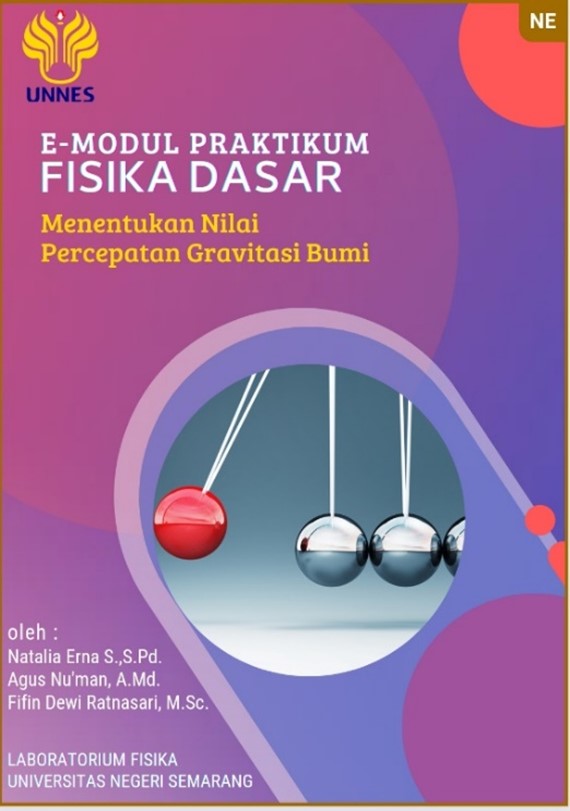Fundamental physics practicum e-module to determine the value of the Earth's gravitational acceleration based on recorded experiments
DOI:
https://doi.org/10.12928/jrkpf.v9i2.185Keywords:
The electronic module, Earth's gravitational acceleration, recorded the experimentAbstract
The research aims to improve the effectiveness of fundamental physics practicum to determine the value of the Earth's gravitational acceleration, whether online or offline. This type of research is development research. The research was conducted using the 4D Model: define, design, development, and disseminate. The product developed as a module contains a guidebook into an electronic module by integrating a practicum video (recorded experiment) that contains how to use the tools and practicum work steps. Interviews and questionnaires carry out data collection techniques. Questionnaires are given to material, language, and media experts to find out the validity of the e-module. Questionnaires are also given to lecturers who teach fundamental physics courses and students participating in introductory physics courses to find out the feasibility of e-modules. From the study, the average score of material, language, and media experts was 89.08%, stating that the e-module was very valid. At the same time, the average score for the feasibility test is 89.38% which states that the e-module is very feasible. Thus, developing a fundamental physics practicum e-module can increase the effectiveness of the fundamental physics practicum in determining the value of the Earth's gravitational acceleration.
References
Verawati and Desprayoga, “Solusi Pembelajaran 4.0: Hybrid Learning,” Semin. Nas. Pendidik. Progr. Pascasarj. Univ. PGRI Palembang, pp. 1183–1192, 2019.
S. Sungkono, A. A. Nugroho, and E. Miyarso, “Tingkat kepuasan pengguna dan analisis kebutuhan pengembangan Laboratorium Jurusan,” Epistema, vol. 1, no. 2, pp. 94–102, Oct. 2020, https://doi.org/10.21831/ep.v1i2.34985j.
U. M. Nisa, “Metode praktikum untuk meningkatkan pemahaman dan hasil belajar siswa kelas V MI YPPI 1945 Babat pada materi zat tunggal dan campuran,” Proceeding Biol. Educ. Conf. Biol. Sci. Enviromental, Learn., vol. 15, no. 1, pp. 62–68, 2017.
R. Susanti, “Pengaruh Penerapan Pembelajaran berbasis Masalah pada Praktikum Fotosintesis dan Respirasi untuk Meningkatkan Kemampuan Generik Sains Mahasiswa Pendidikan Biologi FKIP Unsri,” Pendidik. Biol. FKIP Unsri, pp. 1–14, 2013, [Online]. Available: https://repository.unsri.ac.id/18497/1/Makalah_Seminar_Kenaikan_Jabatan.pdf.
Nasrodin, N. Hindarto, and S. S. E., “Analisis Kebiasaan Bekerja Ilmiah Mahasiswa Fisika Pada Pembelajaran Mata Kuliah Praktikum Fisika Dasar,” Unnes Phys. Educ. J., vol. 2, no. 1, pp. 84–91, 2013.
Nurhayati, R. D. A. A, and S. Aslamiyah, “Penentuan Nilai Percepatan Gravitasi Bumi dengan Model Gerak Jatuh Bebas di Laboratorium Fisika UIN Ar-Raniry Banda Aceh,” J. Phi J. Pendidik. Fis. dan Fis. Terap., vol. 2, no. 1, pp. 15–18, 2021.
F. Dwiatmoko, “Rancang Bangun Percobaan Bandul Fisis Berbasis Mikrokontroler Untuk Menentukan Periode Minimum,” Inov. Fis. Indones., vol. 8, no. 1, pp. 1–4, 2018.
M. Ariska, “Penyelesaian Dinamika Pesawat Atwood dengan Persamaan Eular-Lagrange Sebagai Alternatif Persamaan Newton Pada Fisika SMA,” J. Inov. dan Pembelajaran Fis., vol. 6, no. 1, pp. 62–69, May 2019, https://doi.org/10.36706/jipf.v6i1.7816.
N. Wijayanti, D. Wahyuningsih, and D. T. Rahardjo, “Pengembangan E-Modul Praktikum Listrik Magnet pada LMS Moodle di Laman Spada UNS dengan Model Inkuiri Terbimbing untuk Mahasiswa Pendidikan Fisika,” J. Mater. dan Pembelajaran Fis., vol. 10, no. 2, p. 110, Oct. 2020, https://doi.org/10.20961/jmpf.v10i2.54347.
Erniwati, R. Eso, and S. Rahmia, “Penggunaan Media Praktikum Berbasis Video Dalam Pembelajaran Ipa-Fisika Untuk Meningkatkan Hasil Belajar Siswa Pada Materi Pokok Suhu Dan Perubahannya,” J. Sains dan Pendidik. Fis., vol. 10, no. 3, pp. 269–273, 2014.
A. Y. Utomo and D. Ratnawati, “Pengembangan Video Tutorial dalam Pembelajaran Sistem Pengapian di SMK,” Taman Vokasi, vol. 6, no. 1, p. 68, Jun. 2018, https://doi.org/10.30738/jtvok.v6i1.2839.
G. E. Averina, S. Sumpeno, and A. Zaini, “Pengembangan Media Penunjang Praktikum Daring Fisika Dasar Berbasis Multimedia Interaktif,” J. Tek. ITS, vol. 10, no. 2, Dec. 2021, https://doi.org/10.12962/j23373539.v10i2.70702.
K. A. Rakhman, A. R. Saraha, and N. Sugrah, “Pengembangan video penggunaan alat gelas laboratorium kimia di universitas,” J. Inov. Pendidik. IPA, vol. 3, no. 2, p. 161, Oct. 2017, https://doi.org/10.21831/jipi.v3i2.15667.
N. Nurwati and H. Purwanti, “Pemanfaatan Video Tutorial (Demonstrasi) pada Pembelajaran Pcki di Masa Pandemi Covid-19,” J. Ilm. WUNY, vol. 3, no. 2, Jan. 2022, https://doi.org/10.21831/jwuny.v3i2.42426.
M. S. A. Dewi and N. A. P. Lestari, “E-Modul Interaktif Berbasis Proyek terhadap Hasil Belajar Siswa,” J. Imiah Pendidik. dan Pembelajaran, vol. 4, no. 3, pp. 433–441, 2020.
S. Ramadhan, Y. Asri, E. Sukma, and V. Indriyani, “Design of learning modules writing factual text based on discovery learning by using mobile devices,” 2020, https://doi.org/10.4108/eai.11-12-2019.2290894.
G. Sossou, F. Demoly, H. Belkebir, H. J. Qi, S. Gomes, and G. Montavon, “Design for 4D printing: Modeling and computation of smart materials distributions,” Mater. Des., vol. 181, p. 108074, Nov. 2019, https://doi.org/10.1016/j.matdes.2019.108074.
M. M. Malik, Adam and Chusni, Pengantar Statistika Pendidikan: Teori dan Aplikasinya. 2018.
A. Sudijono, Pengantar Statistik Pendidikan. 2021.
R. T. Sari, “Uji Validitas Modul Pembelajaran Biologi pada Materi Sistem Reproduksi Manusia melalui Pendekatan Konstruktivisme untuk Kelas IX SMP,” Sci. Educ., vol. 6, no. 1, p. 22, Jun. 2017, https://doi.org/10.24235/sc.educatia.v6i1.1296.

Downloads
Published
Issue
Section
License
Copyright (c) 2022 Natalia Erna Setyaningsih, Agus Nu’man, Fifin Dewi Ratnasari, Danang Subarkah Hadi Kawuryan

This work is licensed under a Creative Commons Attribution-NonCommercial 4.0 International License.







